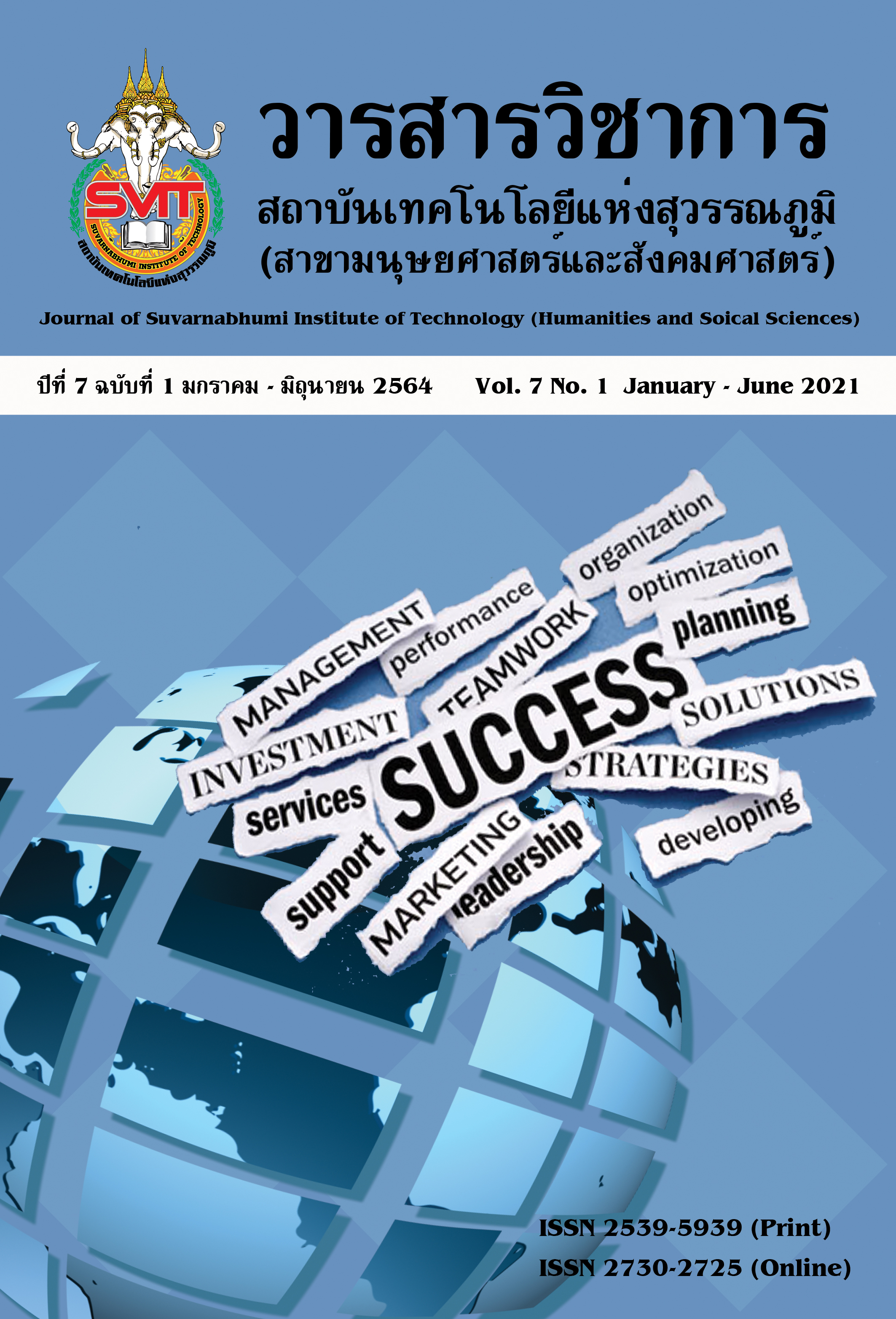A MODEL OF THE INNOVATIVE LEADERSHIP OF SCHOOL ADMINISTRATORS IN WORLD-CLASS STANDARD SCHOOLS
Keywords:
: innovative leadership, school administrators in world-class standard schoolsAbstract
This research aimed to 1).study the factors of the innovative leadership of school administrators in world-class standard schools, 2). create the appropriate model of the innovative leadership of school administrators in world-class standard schools, and 3). assess the appropriate model of the innovative leadership of school administrators in world-class standard schools. There were five steps in the research process: review of theories and related documents, development of research tools, data collection, data analysis, and the composition confirmation of the process.
The samples comprised 303 school directors and the deputy directors of academic affairs and teachers for academic supervisors of the world-class standard schools, obtained by stratified random sampling. The instrument was a 5-level rating scale questionnaire with the content validity between 0.60-1.00 and the reliability of 0.94. The statistics employed for data analysis were percentage, mean, standard deviation, exploratory factor analysis and confirmatory factor analysis.
The findings:
- Seven factors of the innovative leadership of school administrators in world-class standard schools were found: factor 1, risk management system with 8 variables; factor 2, ethics and professional ethics with 8 variables; factor 3, digital and technological with 7 variables; factor 4, teamwork and innovation development promotion with 6 variables; factor 5, innovation plan strategies with 4 variables; factor 6, transformational leadership with 5 variables; and factor 7, innovative creation collaboration with 3 variables.
- The model of the innovative leadership of school administrators in world-class standard schools comprised 7 factors; risk management system, ethics and professional ethics, digital and technological, teamwork and innovation development promotion, innovation plan strategies, transformational leadership, and innovative creation collaboration.
- The assessment of the model of the innovative leadership of school administrators in world-class standard schools was found that the factors are consistent with empirical data, with the harmonious index based on criteria ( =355.35, df=772, p=1.00, CN=740.47, GFI= 0.94, AGFI=0.93, RMSEA=0.00, SRMR=0.03) The construct reliability is 0.98 The variance extracted iof 0.89 The component explained the model of the innovative leadership of school administrators in world-class standard schools at 98 percent.
References
กระทรวงศึกษาธิการ. (2553). แนวทางการดำเนินงานโรงเรียนมาตรฐานสากล. World class standard school. กรุงเทพฯ: ชุมนุมสหกรณ์การเกษตรแห่งประเทศไทย.
กระทรวงศึกษาธิการ. (2561). แนวทางบริหารจัดการหลักสูตรสถานศึกษากลุ่มสาระการเรียนรู้คณิตศาสตร์และวิทยาศาสตร์ (ฉบับปรับปรุง พ.ศ. 2560) ตามหลักสูตรแกนกลางการศึกษาขั้นพื้นฐาน. กรุงเทพฯ: ผู้แต่ง.
ขวัญชนก โตนาค, และคณะ. (2557). การวิเคราะห์องค์ประกอบภาวะผู้นำเชิงนวัตกรรมสำหรับผู้บริหารสถานศึกษาขั้นพื้นฐาน. วารสารศึกษาศาสตร์มหาวิทยาลัยนเรศวร, 16(4), 131-140.
วิมล จันทร์แก้ว. (2555). รูปแบบการพัฒนาภาวะผู้นาเชิงสร้างสรรค์ของผู้บริหารสถานศึกษาสังกัดสำนักงานเขตพื้นที่การศึกษาประถมศึกษา สุราษฎร์ธานี เขต 3 (ปริญญานิพนธ์ปริญญาคุรุศาสตรดุษฎีบัณฑิต). มหาวิทยาลัยรังสิต.
เวียงวิวรรธน์ ทำทูล. (2557). ภาวะผู้นำเชิงนวัตกรรมของผู้บริหารที่ส่งผลต่อองค์การขีดมรรถนะสูงของโรงเรียนในสังกัดสำนักงานเขตพื้นที่การศึกษามัธยมศึกษา เขต 21 (ปริญญานิพนธ์ปริญญาคุรุศาสตรดุษฎีบัณฑิต). มหาวิทยาลัยขอนแก่น.
สุภาวดี นพรุจจินดา. (2553). องค์ประกอบภาวะผู้นำของผู้บริหารวิทยาลัยพยาบาล สังกัดกระทรวงสาธารณสุข. บัณฑิตวิทยาลัย มหาวิทยาลัยศิลปากร.
สุรินทร์ พิศสุวรรณ. (2556). ปัญหาการศึกษาไทยกับการด้อยขีดความสามารถในการแข่งขันระดับโลก. สืบค้น 26 ธันวาคม 2561, จาก https://www.facebook.com/notes/714285441918749
สมศักดิ์ คงเที่ยง. (2555). หลักบริหารการศึกษา. กรุงเทพฯ: พี.เอ.ลีฟวิ่ง.
เสนาะ ติเยาว์. (2551). หลักการบริหาร (พิมพ์ครั้งที่ 9). กรุงเทพฯ: มหาวิทยาลัยธรรมศาสตร์.
สำนักงานคณะกรรมการการศึกษาขั้นพื้นฐาน. (2555). แนวทางการจัดการเรียนการสอนในโรงเรียนมาตรฐานสากล (ฉบับปรับปรุง). กรุงเทพฯ: ชุมนุมสหกรณ์การเกษตรแห่งประเทศไทย.
ศศิประภา ชัยประสิทธิ์. (2553). องค์กรแห่งนวัตกรรม: ทางเลือกของผู้ประกอบการยุคใหม่. วารสารนักบริหาร, 30(2), 60-63.
Cheriakakramcherry, S. A. (2019). Principals: innovative leadership work behaviors in relation to student achievement in reading and mathematics. Arizona: Grand Canyon University Phoenix.
Comrey, A. L., & Lee, H. B. (1992). A first course in factor analysis. New Jersey: Erlbaum.
Cronbach, L. J. (1984). Essentials of psychological testing (4th ed.). New York: Harper and Row.
Dibbon, & Pollock. (2007). The Nature of Change and Innovation in Five Innovative Schools. The Innovation Journal: The Public Sector Innovation Journal, 12(1), 1-15.
Hall, D. (2007). Graduation Matters: Improving Accountability for High School Graduation. Retrieved from https://eric.ed.gov/?id=ED497689
Horth, D. (2009). Innovation leadership: How to use innovation to lead effectively, work collaboratively, and drive results. Retrieved from http://www.imagineeducation.com.au/files/ReadingsBSBINN502/Innovation_ Leadership.
Keeves, P. J. (1988). Educational research methodology and measurement: An international handbooks. Oxford: Pergamon Press.
Likert. R. (1932). A technique for the measurement of attitudes. New Jersey: McGraw-Hill.
Lindegaard, S. (2009). The open innovation revolution: Essentials, roadblocks, and leadership skills. New Jersey: John Wiley & Sons, Hoboken.
Loader, A. (2016). Why should you show innovative leadership. Retrieved 20 August, 2018, from http://blog castle.co/innovative-leadership.
Patel, E. (2012). The Essentials of School Leadership. London: Paul Chapman.
Robert, F. B., & Jeff, Z. (2010). Leadership vacuums and overcoming barriers to innovation. Retrieved August21, 2018, from http://www.business-strategy-innovation.com/2010/04/leadershipvacuums-and-overcoming.html
Stogdill, R. M. (1989). Handbook of leadership: Survey of theory and research. New York: Free Press.
Watt, D. (2002). How innovation occurs in high schools within the network of innovative schools: The four pillars of innovation research project. Retrieved from http://www.schoolnet.ca/nisrei/e/research/pillars/index.asp
Downloads
Published
Issue
Section
License
บทความที่ได้รับการตีพิมพ์เป็นลิขสิทธิ์ของวารสารวิชาการ สถาบันเทคโนโลยีแห่งสุวรรณภูมิ
ข้อความที่ปรากฏในบทความแต่ละเรื่องในวารสารวิชาการเล่มนี้เป็นความคิดเห็นส่วนตัวของผู้เขียนแต่ละท่านไม่เกี่ยวข้องกับสถาบันเทคโนโลยีแห่งสุวรรณภูมิ และคณาจารย์ท่านอื่นๆในสถาบันฯ แต่อย่างใด ความรับผิดชอบองค์ประกอบทั้งหมดของบทความแต่ละเรื่องเป็นของผู้เขียนแต่ละท่าน หากมีความผิดพลาดใดๆ ผู้เขียนแต่ละท่านจะรับผิดชอบบทความของตนเองแต่ผู้เดียว




